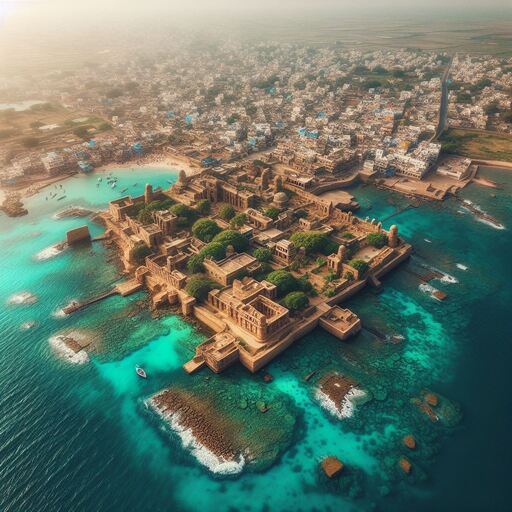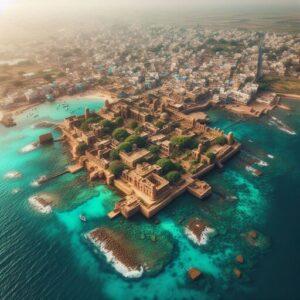
Dwarka: History in Hindu Culture

Dwarka, nestled on the western coast of India, holds a unique and multifaceted significance in Hindu culture. Its rich tapestry is woven with threads of history, religious importance, and symbolism, making it a vibrant and captivating pilgrimage site.
Historical Whispers:
While archaeological evidence suggests Dwarka was indeed a bustling port city around the 15th-18th centuries BCE, the exact timeline and details remain shrouded in debate. Legends associate this historical city with Lord Krishna, the eighth avatar of Vishnu. Whether viewed as a factual ruler or a symbolic figure, Krishna’s association undeniably elevated Dwarka’s historical stature. Ongoing excavations of submerged ruins continue to unearth fascinating clues about the city’s infrastructure, trade connections, and potential influence during its historical period.
History Canvas:
The Mahabharata, the epic Hindu poem, paints a vivid picture of Dwarka as a magnificent and prosperous city built by Lord Krishna. Legends claim he reclaimed land from the sea itself – a testament to his divine powers and the city’s grandeur. These narratives, passed down through generations, have deeply embedded Dwarka in the Hindu consciousness, making it a potent symbol of divine intervention and righteous leadership.
Religious Sanctuary:
Regardless of its historical origins, Dwarka’s association with Krishna cemented its religious significance. Adi Shankaracharya, a revered 8th-century scholar, enshrined it as one of the four holiest pilgrimage sites in Hinduism – the Char Dham. This elevated status attracts countless devotees throughout the year, eager to seek blessings at the majestic Dwarkadhish Temple dedicated to Lord Krishna. Dwarka also finds its place among the seven most ancient and sacred Hindu cities, the Sapta Puri, further solidifying its importance within religious traditions.
Symbolic Legacy:
Beyond historical facts and mythological tales, Dwarka holds deep symbolic meaning. It represents the ideals of a just and prosperous kingdom ruled by a righteous leader like Krishna. The city’s submersion by the sea, as depicted in the Mahabharata, is interpreted in various ways. Some see it as a literal event, while others view it as a symbolic reminder of the impermanence of material things and the cyclical nature of life and death. Regardless of interpretation, the image of Dwarka’s disappearance serves as a powerful reminder of impermanence within Hindu philosophy.
Eternal Inspiration:
Dwarka’s significance extends far beyond its historical and mythological aspects. The city continues to inspire devotion, pilgrimage, and cultural activities, keeping alive the legacy of Krishna and his teachings. Festivals like Rath Yatra, celebrating Krishna’s chariot procession, draw thousands of devotees, while the city’s vibrant cultural scene echoes with traditional music, dance, and storytelling.
In conclusion, Dwarka’s significance in Hindu culture cannot be attributed to a single dimension. It is a complex tapestry woven with historical threads, mythological narratives, religious importance, and enduring symbolism. Understanding these intertwined aspects allows for a richer appreciation of this holy city and its captivating place within the Hindu world.




